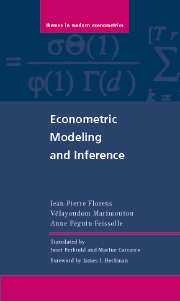Book contents
- Frontmatter
- Contents
- Foreword
- Preface
- I Statistical Methods
- 1 Statistical Models
- 2 Sequential Models and Asymptotics
- 3 Estimation by Maximization and by the Method of Moments
- 4 Asymptotic Tests
- 5 Nonparametric Methods
- 6 Simulation Methods
- II Regression Models
- III Dynamic Models
- IV Structural Modeling
- Bibliography
- Index
6 - Simulation Methods
- Frontmatter
- Contents
- Foreword
- Preface
- I Statistical Methods
- 1 Statistical Models
- 2 Sequential Models and Asymptotics
- 3 Estimation by Maximization and by the Method of Moments
- 4 Asymptotic Tests
- 5 Nonparametric Methods
- 6 Simulation Methods
- II Regression Models
- III Dynamic Models
- IV Structural Modeling
- Bibliography
- Index
Summary
Introduction
Simulation methods have in common the use of two random samples: the first is constituted of true observations of the studied phenomenon whereas the second is artificially generated by a computer. The distribution of the first sample is unknown and its size is determined by the available databases. The second sample obeys the will of the statistician, who chooses the generating process and its size depends on the available computing power and time.
There are many different reasons for using simulated data in statistical inference. We restrict our presentation to three uses of simulated data. The first one is motivated by numerical problems in an estimation procedure which we illustrate by providing a method for computing integrals. The other two methods pertain to the analysis of the small sample properties of estimators. On one hand, we may look for the small sample properties of an estimator or a test for a given value of the parameters. On the other hand, we can put forward another distribution of the estimators by the method called bootstrap which we will try to justify by various arguments. The three sections about the uses of simulations are preceded by a brief introduction to techniques for generating random scalars and vectors.
Random Number Generators
Consider a probability distribution on ℝp characterized by its distribution function F. We propose to construct algorithms that allow us to generate sequences of independent vectors with distribution F.
Information
- Type
- Chapter
- Information
- Econometric Modeling and Inference , pp. 103 - 126Publisher: Cambridge University PressPrint publication year: 2007
